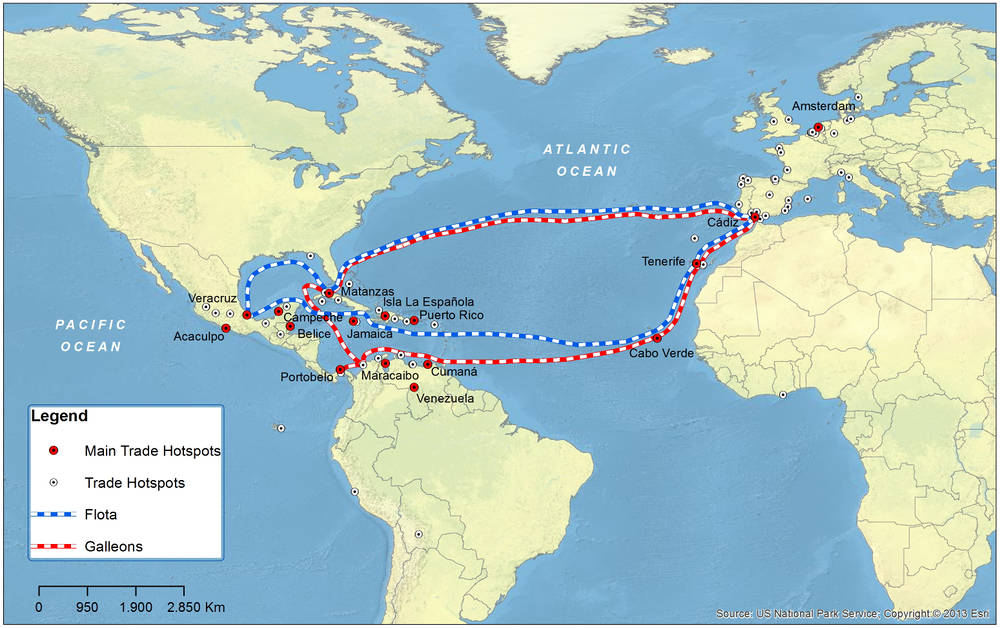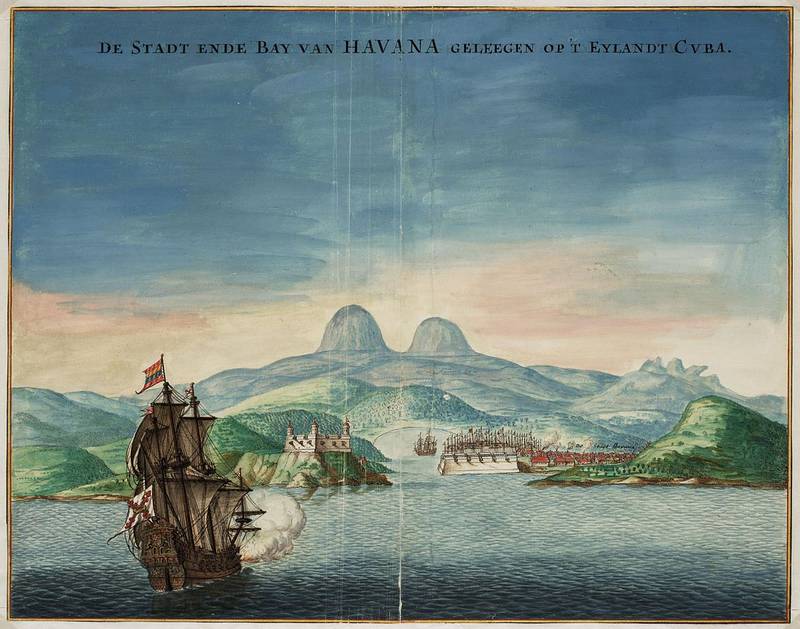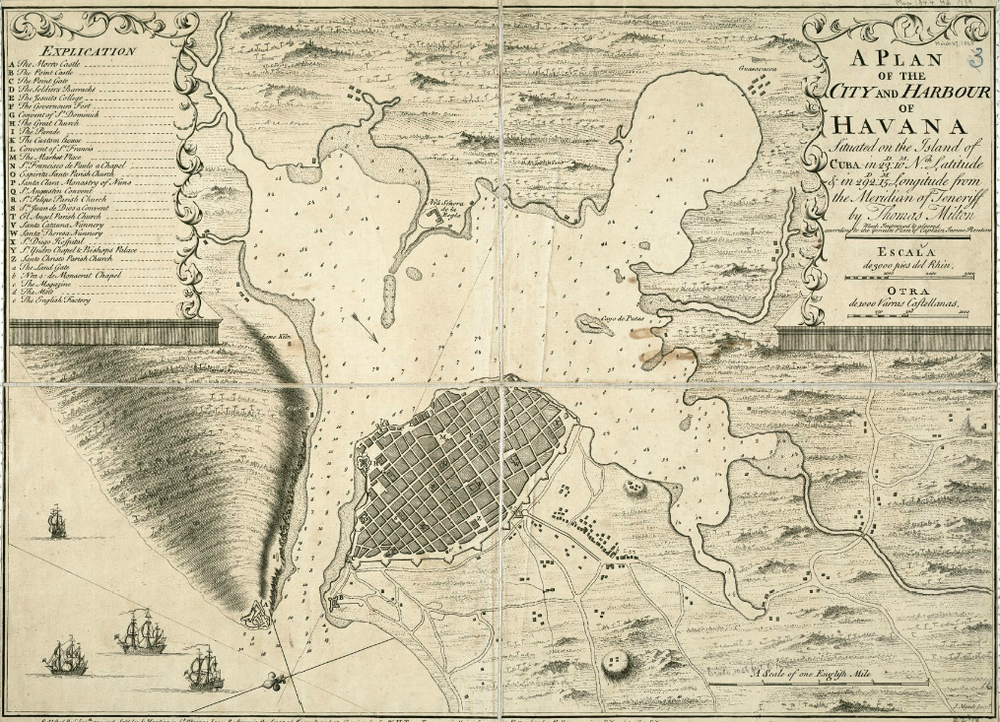Spanish West Indies
Contents
Research questions
- Population size of towns and cities in 1650?
- Position of towns and cities in administrative structures?
Spanish colonial Atlantic trade system in C17th
Ana Crespo Solano describes the long established Spanish colonial trade system in the Atlantic, prior to the Treaty of Utrecht:
"Spanish colonial trade followed a route which ran across the Atlantic from the ports of Andalusia to the Canary Islands and then on to the Antilles. It then forked off in the direction of the approved ports for the two viceroyalties: Peru and New Spain. The Spanish Crown created legislation (influenced mostly by the economic elite close to the kings of Castile) stating that the colonization and exploitation of the Americas was a private enterprise, but with collaboration and fiscal supervision from the Crown by means of a few institutions created for this purpose. Spanish colonial trade between the 16th and 18th centuries was an undertaking which was intended to be a state business (subject to monopolies and licences), but privately financed. This was a model which had previously been developed in Europe when commercial traffic took place within a particular area, as in the case of Cantabrian trade with Flanders (Flanders Route and Eastern Route from the Middle Ages onwards), trade with the Hansa, or even Portuguese trade from the 14th century. In 1569, the two fleets were clearly identified: the Flota de Nueva España (Fleet of New Spain), with a final destination in the port of Veracruz (required to set sail from Spain in the month of April); and the fleet headed for the continent (Galleons of Terra Firma), bound for Nombre de Dios – a port later replaced by Portobelo (Panama) – which was to depart in August. Every year, these two fleets spent the winter in the Indies and met in March at the port in Havana to undertake the return ocean crossing to the peninsula together (García-Baquero González, 1992)."[1]


Administration of the Americas
The Americas were incorporated into the Crown of Castile, with two key viceroyalties governing the most populous and wealthy regions. The Viceroyalty of Peru was governed from Lima and governed over Peru and South America. The Viceroyalty of New Spain was governed from Mexico Coty and governed over Mexico and the Philippines. In addition the viceroyalty of New Spain supervised other North American, Central American, Caribbean and East Indian areas, and the viceroyalty of Peru supervised other South American teritories. The exception was much of modern Venezuela, which was supervised by the high court or Audiencia of Santa Domingo on the island of Hispaniola.[2]
Places named in depositions
Gilbralt[?er]
Thomas Juan stated by Anthonio De La Rosa to have bought tobacco at "the ffayre att Gibralter in the West India" from several men and "brought it afterwards to Marachio distant about five and twenty leagues from the same port".[3]
Havana


See Wikipedia article: History of Havana
- By a Spanish royal decree of 1561, all ships headed for Spain were required to assemble in Havana BaY. "Ships arrived from May through August, waiting for the best weather conditions, and together, the fleet departed Havana for Spain by September...Goods traded in Havana included gold, silver, alpaca wool from the Andes, emeralds from Colombia, mahoganies from Cuba and Guatemala, leather from the Guajira, spices, sticks of dye from Campeche, corn, manioc, and cocoa. Ships from all over the New World carried products first to Havana, in order to be taken by the fleet to Spain. The thousands of ships gathered in the city's bay also fueled Havana's agriculture and manufacture, since they had to be supplied with food, water, and other products needed to traverse the ocean"[4]
- Havana was designated a City by Phillip II in 1592, and was greatly expanded in the C17th
- Deadly epidemic devastated Havana in 1649, brought from Cartagena
Questions:
- Population size of Havana in 1650?
[ADD DATA]
Hispaniola
See Wikipedia article: Hispaniola
[ADD DATA]
Limma [alt. Lima]
Lima was the governing city of the Viceroyalty of Peru.
Two viceroys governed during the period concerning the three Silver Ships. Pedro de Toledo, 1st Marquis of Mancera (1639-1648)[5] and García Sarmiento de Sotomayor, 2nd Count of Salvatierra (1648-1655)[6] García Sarmiento de Sotomayor was viceroy of New Spain (1642-1648), prior to assuming the Viceroyship of Peru in 1648.
The viceroyalty of New Spain was governed from Mexico City.
Wikipedia provides a useful overview of the history of Lima, including the colonial period.[7] The Wikipedia entry for the colonial priod describes the city as a key commercial hub: "Lima flourished during the 17th century as the center of an extensive trade network which integrated the Viceroyalty of Peru with the Americas, Europe and the Far East."[8] "Its merchants channeled Peruvian silver through the nearby port of Callao and exchanged it for imported goods at the trade fair of Portobelo in modern day Panama."[9] "This practice was sanctioned by law as all trade from the Viceroyalty was required to go through Callao on its way to and from overseas markets. The resulting economic prosperity of the city was reflected in its rapid growth, population expanded from about 25,000 in 1619 to an estimated 80,000 in 1687."[10]
[INSERT MAP OF COLONIAL PERU]
Callao
Marachio
Tobacco laded on board the Nostra Seigniora del Rosario for her master Antonio de la Rosa by twenty-five year old Cadiz merchant Guillermo Crombeen[11]
CHECK whether "Marachio" = modern "Maracaibo", a city near the coast of modern Venezuela
Panama
Panama City was founded in 1519 by the Spamish conquistador Pedro Arias Dávila. "It was a stopover point on one of the most important trade routes in the history of the American continent, leading to the fairs of Nombre de Dios and Portobelo, through which passed most of the gold and silver that Spain took from the Americas."[12]
"Nombre de Dios is the oldest continuously inhabited European settlement in the continental Americas. Originally a major port of call for the Spanish treasure fleet, Nombre de Dios was the most significant port for shipping in the Americas between 1540 and 1580. After the opening of Potosí in 1546, silver was shipped north to Panama City and carried by mule train across the isthmus to Nombre de Dios for shipment to Havana and Spain."[13]
Peru
[ADD DATA]
?Varinas
Tobacco bought at ?Varinas in the West Indies for John Baptista Sabino by Manuel Correa and brought first to Marachaio in the West Indies, and from thence in the Nostra Seigniora del Rosario to Cadiz, where it was laden on board the ships the Sampson and Salvador[14]
CHECK whether Varinas was a province of New Spain
CHECK whether Varinas = "Province of Verina", as described by Alexander von Humboldt[15]
CHECK whether Varinas = "Barinas" in Spanish documents, and "Barinas" in modern Venezulea (which is ca. 200 km south of the coast)
A 1819 British source states that Varinas lay under the government of Caraccas abd gave its latitude as 7 40 0 N. and longitude as blank[16]
Mexican silver mining
- Spanish viceregal state did not participate directly in silver mining[17]
- deep shaft silver mining was introduced into colonial Mexico in the C16th, and by the 1570s was "a dynamic, technologically complex, capital-intensive enterprize owned by a fairly smalll number of creoles or Spaniards, and it continued to be so". Silver mines were located in northern and central New Spain. Northern mines include San Luis Potosí, Zacatecas, Sombrerete, Cuencamé, Topia and Parral. Central mines include Pachuca, Taxco, Sultepec, and Cuautla. Exhaustion of high-quality surface deposits led to deep shaft mining of lower-grade silver oil by 1570s, using mercury to amalgamate with the ore.[18]
- The C17th saw the capital requirements of silver mining increasing as silver yield from amalgamated ore dropped and miners had to purchase more mercury per unit of silver produced[19]
Peruvian silver mining
- Mexican silver mining was superceeded in importance by Peruvian silver mining by the early C17th
- Mining town of Potosí, in modern Bolivia, fell under the viceroyalty of Peru and was known as Alto Peru (Upper Peru). The mining town was founded in 1545, and employed prodigious quantities of indeigenous labourers as well as some imported African slaves.[20]
- An online source, using Library of Congress and CIA Factbook sources, states that "By the middle of the seventeenth century, silver mining at Potosí had become so important that the city had the largest population in the Western Hemisphere, approximately 160,000 inhabitants". The same source desscribes the sophisticated use of hydraulic power, using a system of articfical lakes in place by 1621, to support a number of large refining centers.[21]
[EXPAND]
- Search for "History of Peruvian silver mining"
Potential sources
Kenneth Andrien, Crisis and decline: the Viceroyalty of Peru in the seventeenth century (Albuquerque: University of New Mexico Press, 1985)
D.A. Brading, D. A. and Harry E. Cross. “Colonial Silver Mining: Mexico and Peru.” Hispanic American Historical Review 52 (1972): 545–579.
- A clear, schematic comparison of Mexican and south central Andean silver mining, treating geology, technology, crown intervention, capital structure, and labor.
- cited in Kris Lane, Mining, Gold, and Silver, Oxford Bibliographies (online resource), last modified 25 May 2011
Pierre Chaunu, Séville et l'Atlantique
- collection of statistics on owners, masters, kinds, cargoes, tonnage and routes to and from the Indies 1504-1650
- synthesised in Pierre Chaunu, Conquête et exploitation des nouveaux mondes
Louisa Schell Hoberman, Mexico's Merchant Elite, 1590-1660: Silver, State, and Society (Durham & London, 1991)
- includes discussion of mining and operation of the mint
- discussion of role of merchant producers and financiers (p.72)
Heidi V. Scott, Mapping Peru in the Sixteenth and Seventeenth Centuries (Notre Dame, 2009)
- ↑ Crespo Solana, Ana (2014). “The formation of a social Hispanic Atlantic space and the integration of merchant communities following the Treaties of Utrecht”. Culture & History Digital Journal, 3(1): e007. doi: http://dx.doi.org/10.3989/chdj.2014.007
- ↑ Wikipedia entry: Viceroy: 1. Spanish Empire 1.2 In the Americas
- ↑ HCA 13/67 f.? IMG_117_07_1487
- ↑ Wikipedia article: History of Havana: Pirates and La Flota
- ↑ Wikipedia entry: Pedro de Toledo, 1st Marquis of Mancera
- ↑ Wikipedia entry: García Sarmiento de Sotomayor, 2nd Count of Salvatierra
- ↑ Wikipedia entry: History of Lima
- ↑ Kenneth Andrien, Crisis and decline: the Viceroyalty of Peru in the seventeenth century (Albuquerque: University of New Mexico Press, 1985), pp. 11–13
- ↑ Kenneth Andrien, Crisis and decline: the Viceroyalty of Peru in the seventeenth century (Albuquerque: University of New Mexico Press, 1985), p.16
- ↑ Kenneth Andrien, Crisis and decline: the Viceroyalty of Peru in the seventeenth century (Albuquerque: University of New Mexico Press, 1985), p.30
- ↑ HCA 13/67 f.? IMG_117_07_1466
- ↑ Wikipedia entry: Panama City
- ↑ Wikipedia entry: Nombre de Dios, Colón
- ↑ HCA 13/67 f.? IMG_117_07_1468
- ↑ Map plate of Province of Verina in Humboldt, Alexander von. 1819-1829. Personal narrative of travels to the equinoctial regions of the New Continent, during the years 1799-1804. By Alexander de Humboldt, and Aimé Bonpland; with maps, plans, &c. written in French by Alexander de Humboldt, and trans. into English by Helen Maria Williams. 7 vols. London: Longman, Hurst, Rees, Orme and Brown. Vol. 3.
- ↑ Sir Richard Henry Bonnycastle, Spanish America: Or, A Descriptive, Historical, and Geographical Account of the Dominions of Spain (London, 1819), p.450
- ↑ Louisa Schell Hoberman, Mexico's Merchant Elite, 1590-1660: Silver, State, and Society (Durham & London, 1991), p.73)
- ↑ Louisa Schell Hoberman, Mexico's Merchant Elite, 1590-1660: Silver, State, and Society (Durham & London, 1991), p.73)
- ↑ Louisa Schell Hoberman, Mexico's Merchant Elite, 1590-1660: Silver, State, and Society (Durham & London, 1991), p.74)
- ↑ Wikipedia article: Potosí: History and silver extraction
- ↑ Bolivia The Economy of Upper Peru, sourced from The Library of Congress Country Studies; CIA World Factbook (1989)